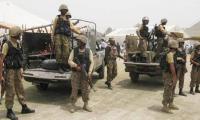Our acquaintance with Sri Lanka has more to do with cricket than its history or geography. But recently, two avenues of further commonality have emerged in unexpected ways.
The first common feature arises in the form of Sri Lanka’s total debt, especially its external one. As usual, the government’s figures tend to be on the lower side while independent estimates are on the higher side. The second common feature comes in the form of Sri Lanka’s dream to establish a port like Gwadar (Hambantota) and an arrangement like the CPEC with the help of China. Its present predicament, however, offers an interesting insight into public policy and economic management.
Sri Lanka’s external debt, as per independent reports, is around $58 billion, and its debt payments are more than 90 percent of its total income from taxes. A major part of this colossal debt can be attributed to Sri Lanka’s dream of moving forward through large infrastructure investments, one of which is Hambantota. Between 2008 and 2014, its domestic debt tripled and foreign debt doubled (sounds familiar, does it not?). Its prime minister recently admitted in parliament that the government does not have an exact figure for its total debt. Earlier this month, a few government departments in Pakistan were also asked to get together in order to come up with a single figure on its total debt.
Hambantota was a sleepy port town with little noticeable economic activity till Mahinda Rajapaksa was elected as Sri Lanka’s president. Hambantota was his home town and he envisioned grand plans for it. These plans included a deep sea port, an airport of international standard, a cricket stadium, an LNG plant, tourist resorts and an industrial zone. But financing these grandiose plans was a problem. In came China with a promise of $8 billion in soft loans and a chance to expand on its ‘one road, one belt’ policy. And so development of infrastructure in this area began.
Today, the Mattala airport in Hambantota is sitting idle – hardly two flights a day are scheduled. Cricket stadium and conference centres are rarely used, brand new roads are almost empty, business at the port is sparse and the industrial state has yet to take shape. Everything is in place – except users. This also means there’s little revenue for the government which still has to bear the heavy maintenance expenditure of these facilities.
The government’s estimates, as is usually the case, turned out to be overoptimistic. And guess who’s footing the bill for these monuments of little use? The Sri Lankan taxpayers, of course, who were not even part of the decision to initiate these grandiose ventures. It has been reported that the present government wanted to sell the various infrastructure facilities to lenders but it was more interested in getting its money back rather than operating a loss-making venture.
What went wrong? For a start, the plans for Hambantota were based on political considerations rather than economic necessity. It was Rajapaksa’s home constituency and he wanted to take as much political mileage out of his position as possible. His idea of doing that came in the form of building a concrete city, despite the place being a rural outpost known more for migrating elephants than its business potential. But Rajapaksa aimed to turn logic on its head with the help of Chinese money. Unfortunately, his plans for squeezing political eminence turned to dust as he lost the elections.
Gwadar and the CPEC represent some interesting comparisons. Gwadar is an outpost in the middle of nowhere – a rural setting which lacks modern facilities. It is located in a province which is almost half the size of Pakistan but is sparsely populated. It is from this province that the main arteries of the CPEC will pass and it is in Gilgit-Baltistan where they will ultimately end. But both provinces lack the population density to initiate or sustain a business surge. Simply put, there are not enough customers or producers to make it a business metropolis which can attract business and freight transport from all around the world. While all this is clear to most analysts, infrastructure of every kind is still emerging and more grandiose plans are in the offing.
As in Rajapaksa’s case, our leadership is making a very concerted effort to take political mileage out of this by terming the CPEC a victory of their ‘vision’. That is, of course, not true since if it were not for China, nobody had any interest in Gwadar and the Pakistani state by no means has any capacity to undertake such an extensive venture. And like Hambantota, the CPEC dreams are built upon Chinese loans (which mind you, will have to be paid back). The recent celebrations surrounding the first CPEC trade convoy are a bit far-fetched since the event cost us heavily. What makes our policymakers and leaders so sure that trade and related activities will blossom to an extent that we will not only pay back the loans but that the infrastructure projects will pay for themselves in the future?
Building the infrastructure of the CPEC or Hambantota is a major long-term venture which requires technical and administrative competence, patience and continuous cash flows. Pakistan’s government machinery possesses none of these attributes. But, undeterred by its poor capacity and ability to undertake these projects, we still latch on to infrastructure projects as our saviours. The new planned motorways (financed by loans) and projects like the Metro-Bus project (running in losses) are a recent, poignant reminder.
An important lesson that policymakers in Pakistan can learn is that copying other countries in how they run their economy is not necessarily a recipe for success. I have observed people from all walks of life in Pakistan, including economists, making allusions to the Chinese state’s large footprint in its economy in order to advocate the same case for Pakistan. But they rarely realise that the Chinese state has enough fiscal space to sustain such an undertaking. Whether it’s uninhabited ghost cities or the danger of lower growth rates, the Chinese government has enough fiscal muscle to prevent these kinds of instances from turning into failures. We, on the other hand, are living on borrowed money.
With our fingers crossed, we will wait for all the wonderful dreams shown to us to come to fruition in reality. We will hope that the CPEC doesn’t turn into a Hambantota-like disaster. Otherwise, guess who’s going to foot the bill?
The writer is a freelance contributor.
shahid.mohmand@ gmail.com
@ShahidMohmand79
Many people believe that in future, AI will play an even more significant role in their lives
In April 2024, three Chinese and one Belarusian company were sanctioned for exporting missile-enabling technology to...
Pakistan has second highest neonatal mortality in world; in education sector, country's 26 million kids are out of...
Key actors in global power politics are US, China, Russia, European Union, and emerging powers such as India and Brazil
Maulana Fazl manages to bring together factions that historically stand opposed
NASA says August 2024 set new monthly temperature record, capping Earth’s hottest summer since 1880







